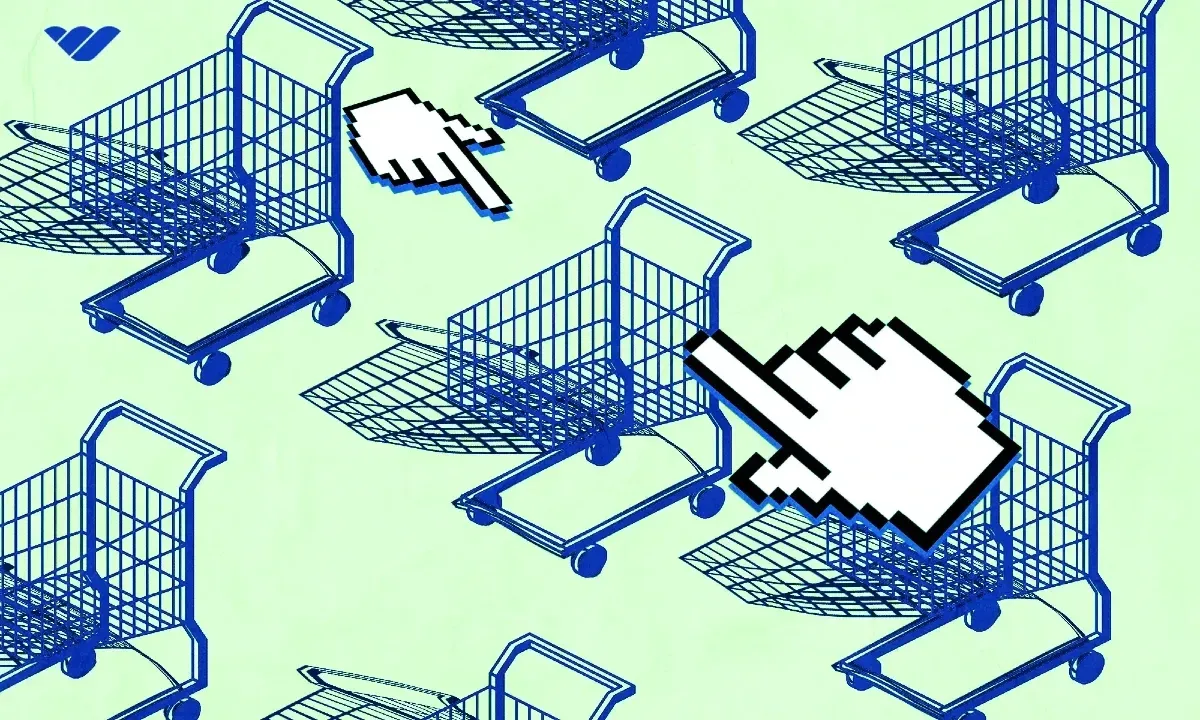Ecommerce is a thriving industry, with more than half of shoppers (56%) opting to shop online rather than in store. Of this number, 27% of online shoppers across the world regularly spend their money online. And, with ecommerce growth set to reach a jaw-dropping $8 trillion by 2027, this industry can be lucrative for many businesses.
Despite the online market being a treasure trove of potential and profits, its growth also presents challenges. With such a saturated market many businesses fail, and rivalry is tough.
Navigating this arena with experience tests even the experts to their limits, so start-ups need as much help as possible. One crucial aspect of a successful ecommerce store is understanding and implementing pricing strategies.
But what are pricing strategies? In this guide, we will explore what pricing strategies are and why they are important for all businesses, especially smaller ones.
What are Pricing Strategies?
A pricing strategy is an approach used by ecommerce businesses and retail owners to decide the prices to assign to their products that will cover costs, increase sales, and make a profit. Pricing strategies can also take into consideration customer value, revenue goals, and competitor prices.
After implementing a strategy, it is vital to keep track of its success. By tracking success, you can determine whether to switch to another price strategy or stick with your initial choice. Alternatively, you can run different pricing strategies simultaneously and then use A/B split testing to determine which is the most profitable.
Understanding the Importance of Pricing Strategies
With 80% to 90% of new businesses failing within the first four months of opening their online store, it is becoming increasingly important to understand and implement pricing strategies. As online spending increases globally, the ecommerce market becomes more competitive, so it is crucial to price your products thoughtfully, considering the perceived value of your product, the going market rate, and the profit you need to make to grow your business.
Most large-scale dropshipping businesses already use price skimming, dynamic pricing, and others. This practice proves that it is essential for small businesses to explore their options and do the same. With so many hurdles to overcome, small businesses must use every resource at their disposal rather than ignoring this vital aspect of commerce – both online and offline.
12 Ecommerce Pricing Strategies
Here are the twelve of the most popular pricing strategies used in commerce and ecommerce. Some companies also develop their own models or combine strategies to optimize their sales and profits.
1. Cost-based pricing
Probably one of the easiest pricing strategies is the cost-based pricing model because it relies on factual data rather than subjective market influences. This approach means that the strategy focuses on the business rather than the consumer. Because of its simplicity, it is convenient, which also makes it a popular pricing strategy.
An oversimplified explanation of this pricing model looks like this:
As an ecommerce business owner, you buy and sell scented soaps, candles, and similar items. If you buy 100 candles at $1 each, packaging costs $15, and shipping is $30, this order will cost you $145. After dividing this total by 100, you arrive at a unit price of $1.45. Once you add a profit margin of 66.66% ($4.35), you have a selling price of $5.80 per candle.
Using this pricing model is typically more complex, especially for larger businesses, and looks like this:
Depending on your business, you should separate the material, labor, and overhead costs and spread these across the item you're selling to arrive at the true cost of the product or service. Only then can you generate an accurate figure and include your markup to determine your selling price.
This pricing strategy works well for mass-produced items and small businesses. However, this pricing strategy is one-sided because it focuses only on the company's internal influences, ignoring external market forces. Ignoring other aspects that affect pricing can mean that the product is over- or undervalued, requiring a deeper look at the model for a specific product.
2. Dynamic pricing
Known as dynamic pricing due to its flexible approach that pivots rapidly to benefit from changing market conditions, this model requires observation and vigilance to be successful.
This dynamic pricing strategy can benefit any ecommerce store with the resources to conduct regular SWOT analyses (strengths, weaknesses, opportunities, and threats). A regular SWOT analysis requires examining internal organizational strengths and weaknesses and external threats and opportunities posed by competitors, customers, and regulatory threats to explain this model in simplified theory.
In practical terms, business owners must research competitor prices and the flow of product supply and demand. It will also be necessary to analyze whether the market is saturated with competitors or if new entrants will pose a threat to pricing and profits.
Additionally, setting dynamic pricing means lower or higher prices than competitors (but not too low to start a price war or too high to chase away customers). It also involves lowering prices when product supplies are high and the opposite. A low-price strategy is also beneficial to discourage new businesses from entering the market. Further, a dynamic pricing strategy is valuable when reducing excess, aging stock by lowering prices and attracting high sales.
Implementing this strategy effectively means always looking for ways to optimize profits, but it requires vigilance and resources. Either you have these assets or need a well-planned app to track market changes and adapt prices in response to these movements. Either way, the extra resources and expenses must warrant the profits to be worth the effort of this pricing strategy.
3. Competitor or market-based pricing strategy
As the name suggests, the focus of this model revolves around competitor prices. And like other pricing models, it is pretty simple to calculate after researching competitor product prices.
First, identify your competitors and check that you serve the same markets. From there, identify a product you want to price and determine whether the quality of your products is on par. From here, you can move forward with calculating a product price.
A practical way to do this task is to write down the names of about five or more company rivals. Then record what they're charging for the product you want to sell.
The next step is to take the lowest and highest prices of the products you're comparing. Add these figures and divide them by 2. The result will give you the average market selling price, which is also the starting point for your selling price.
However, using common sense with this consumer-based pricing model is still necessary. Always check if the average price will cover your costs and generate an acceptable profit margin.
Also, you may have a very loyal customer base willing to pay more than average, and you could be losing out on profits because you misread their purchasing behavior. And although it may be tempting, the experts warn not to drop your price below the average - price relates to perceived value, and you do not want your customers to assume that your product is of low value because it is low cost.
Finally, this model can become time-consuming to monitor and adjust constantly despite being easy to use. You can overcome this hurdle by buying apps to track price changes if you're willing to add another overhead to eat up your profits. If not, other pricing strategies could work better for your situation.
4. Loss leader pricing strategy

Loss leader pricing might be right for you if you enjoy sneaky, side-door tactics. This pricing model uses simple tricks to attract potential customers to your ecommerce store.
You encourage interest by placing adverts for low-cost products requiring refills or repeat order items. You get more traffic when customers click on the advert to see why the product is priced so low. Once on your site, you hope your ploy has worked, and your customers will buy the low-priced item. After that, the plan is that they come back to your store to purchase refills that work with that product.
For example, you may sell pet food dispensers at low prices. After buying these dispensers, you encourage return visits to buy pet food. Alternatively, if your store sells aromatherapy diffusers, you sell these cheaply to attract repeat purchases for the oils that work with the diffusers. Consequently, higher pet food or oil sales will cover the losses or low profits of the main product.
After luring customers to your site with the cheap price bait, there is potentially another benefit of the loss-leader pricing strategy. Once there, they may want to stay longer, explore further, and add other products to their cart.
This trick sacrifices profits and risks losses on one item in exchange for potential repeat sales and profits on complementary items, hence the name. So if you sell paired products, you could become a loss leader by experimenting with this strategy.
5. Consumer or value-based pricing
Combining the business, competitor, and consumer, the pricing model is more balanced and generates better value. But this strategy is not without its complexities. By introducing other components (the customer and their values), product pricing becomes more complex. However, the extra time and effort in developing this model comes with greater rewards in the form of higher profits.
Although this model may sound promising at first glance, ecommerce store owners should proceed cautiously. The extra "value" you want more profits for requires your product or service to include a quality that differentiates it from the competition.
Whether that unique selling point (USP) includes organic materials, renewable packaging, charitable partnerships, or some other benefit, your sales will prove if your customers agree with your value-added cost estimate.
Calculating the basic formula for this model looks like this:
Translated into an example, the product's price calculation will look like this:
Average selling price (competitor-based strategy) = $16
Profit - $16 - $10 = $6
Value-based price - $16 (average selling price) + $3 (USP) = $19
The profit has now risen from $6 to $9 because of the extra value you believe your product is worth and what your customers will be willing to pay.
Although it looks easy to calculate, setting prices based on this model requires extensive market research and experience. Unless you have this background or can afford to work on a trial-and-error basis, it may be better to look at safer options.
Why? Because even the most respectable companies have overestimated their USP and paid the price of losing sales and reputation when customers rejected their calculations.
6. Bundle pricing strategy
In theory, many of these pricing models are easy to calculate, but complexity and risk arise when estimating all the variables that could affect sales. These variables include costs, competitors, consumers, internal and external market factors, and government regulations. Despite all these factors, bundle pricing is quite an intuitive and exciting pricing model.
When products are common, like bath soap, shampoo, and moisturizers, competition is fierce. This rivalry drives prices downwards, so profit margins are low. One way to overcome this obstacle is to get creative. Bundle pricing could be the solution to introducing a value-added proposition that increases your overall profits.
Create a bundle of related products that typically sell well with others that do not, like hygiene products or food staples. Taking the earlier example of bath and hair items, you could add slower sellers like hair accessories. The plan here is to sell complementary items for less, but that still pushes up the average order value (AOV).
To calculate the AOV, divide your monthly revenue by the number of products sold. This figure will tell you the average selling price per item customers bought from your ecommerce store.
By bundling related products, you can sell fast-selling products with slow movers at a lower overall price. Bundling increases the sales of slow-movers and fast-moving items because customers appreciate the value they get from the bundle. So, even if the bundle is sold as one item, it elevates the AOV, increasing sales and profits. This strategy works well with related digital products, and it is also helpful when you need to sell older stock to make shelf room for new products.
Again, it is vital to determine costs and profits when engaging in this pricing strategy to ensure that you don't lose on the deal.
7. Subscription Pricing Strategy

A subscription-based pricing strategy is one where your customers pay you a recurring fee, whether that is weekly, monthly, quarterly, or other. This pricing strategy is typically used with SaaS businesses and streaming services (like your monthly fee for Netflix or Spotify Premium) but can also be employed by any ecommerce business.
If your ecommerce business sells stationary, then you could sell a quarterly curated stationary box. If you sell pet supplies, then you could introduce a monthly box for pet food, treats, and hygiene products.
This pricing strategy works well as it usually leads to increased customer retention. It provides convenience for your customers as they don't have to think about going to the shops and buying these products at regular intervals, and extra value for your business as you get the benefit of recurring revenue.
When introducing this pricing strategy you have to think very carefully about the prices that you are setting. Consider the cost of software development and maintenance, customer acquisition costs, and how many customers you need to subscribe to this service in order to make it profitable. Also take into account subscription lengths and add-ons. For example, consider introducing a higher price for a month-to-month subscription and a discounted cost for a yearly commitment to lock-in customers for the long-term.
8. Odd pricing / psychological or charm pricing
Known by several names, the odd or psychological pricing technique uses odd numbers to price products. According to studies, odd numbers, particularly number nine, attract higher sales. The reason for this lies in how the human brain processes numbers.
When customers see a product with a price of $9.99 next to one with a price of $10, most choose the first. Known as a left digit effect, a cognitive bias that reads numbers from left to right and places greater importance on the first number. This strategy works best when a noticeable reference price is used.
For example, if the focal price is $10 and is marked down (the reference price) to $9.99, perception plays a strong role in the left-digit effect. But if the reference price is not there, customers look at the product price and use conceptual memories to influence their buying behavior, processing a whole number.
More psychological influences are at play with this pricing model. For example, customers will more likely fall for charm pricing if they see prices side by side. But no matter how appealing this strategy seems, high volume, low sales businesses must calculate its effect on profit margins and sales. In contrast, experimenting with odd pricing is worthwhile if your profit margins are strong.
9. Price skimming
Ecommerce sellers often employ price skimming, using advertising terms like:
- Limited edition
- Limited availability
- Limited period
- Exclusive offer
- Introductory offer
- Be the first to own
Advertising phrases like these are designed to promote specific responses. They either make customers feel that owning the product will make them feel special, that they will miss out if they don't buy it now, will lose out on the change to save money, or some other benefit.
Scarcity, urgency, and exclusivity drive purchasing behaviors, giving ecommerce store owners a chance to earn more profits. Consequently, when businesses want to create more buzz around products, they set higher prices for expensive brands, advertising them as limited editions to drive urgent purchases. Consumers flock to buy the items, believing they are scarce, unique, or exclusive.
High discounts of 25% or more for 24 hours are another way to encourage sales. This price skimming strategy is often followed with the phrase, "extended for another 24 hours", indicating to consumers the popularity of the item and the urgency to buy before stocks are depleted.
Drumming up excitement and anticipation in advance of a new, introductory product is also a surefire winner for this strategy. When the product hits the shelves, it is sold out within hours – at high prices, generating massive profits. Prices go down once the buzz is over and the product is widely available. By then, you've accomplished your goals.
10. Penetration pricing strategy
When new ecommerce stores or brick-and-mortar businesses enter the market, they face heavy competition. To get a foot in the door and establish themselves, many engage in penetration pricing.
Penetrating new markets that are heavily competitive calls for a strategy that will attract customers and boost sales. The penetration pricing strategy is appropriate because it sets product prices very low.
Low prices mean no profits or very low profits (below competitor averages), but they do drive customers to your store. Once you've grown a customer base, you can then increase your prices. This strategy works well for new businesses, brands, or product lines, helping to compete with established ones.
Penetration pricing is essentially the opposite of skimming, but business owners use an initial low-price strategy instead of clever advertising and high prices. Discounts and promotional offers are integral to this model, drawing customers away from competitors.
Despite many advantages to this pricing model, there is a downside. Customers may expect ongoing low prices and return to rivals when they see prices rising instead. Alternatively, low prices can be perceived as matching low-quality products. As a result, customers could undervalue the brand or product.
These perceptions can easily harm the brand's reputation. If that happens, any profits that were or could have been made from using this strategy won't cover the sales losses that the company may experience while rebuilding its reputation.
11. Price discrimination

As people browse websites, tracking tools often record their behavior, store data, and analyze it for marketing purposes. For example, tracking tools can collect data on how much time they spend on a specific website page, the areas on that page that interest them, and how long they stay on a page or section of the site.
Business owners also use this tool to collect data on buying behavior. When analyzing this data, it becomes obvious which customers place regular orders and those who buy infrequently.
Based on this information, ecommerce owners can segment the customers and determine who is more likely to pay higher prices than others. They also tend to charge registered customers more than unregistered users, hoping to attract business from the second group. In this way, store owners optimize their profits by applying the price discrimination strategy.
Price discrimination thus customizes pricing, selling the same product for different prices to different customer segments. The description of price discrimination above describes the third level.
Level one refers to bidding or auctions where the organizers charge as much as customers are willing to pay for items. Level two describes offering three products for the price of two. The customer can take advantage of price discounts by buying more of a product or purchasing one product at its regular price.
12. Free Trial
Free trials are not only a marketing strategy, but they are a pricing strategy too. In 2023, more than a quarter of ecommerce sellers used free trials in order to attract new customers.
A free trial is simply a limited-time experience of a paid product, for free. Huge companies like Dropbox, Spotify, Hulu and LinkedIn all use free trials to engage customers to sign up for a paid pricing plan. Due to the nature of free trials, this pricing strategy is best suited to SaaS products. Physical retailers may instead opt for giving away a small sample free product (like a face-cream sample) to entice a customer to come back and purchase the full-sized product.
By introducing a free trial, you let existing or prospective customers try out your product for free so that they can understand the benefits and value of it and pay full price once the trial ends. Your free trial can be time-limited such as a 30-day free trial, or, it can be usage-limited, like Vimeo's 25 free video uploads.
A free trial is a great pricing strategy for SaaS businesses, as it can lead to more sales, increased profit, and a higher conversion rate. However, ensure that when you are determining the price of your product post-trial you take into account how much it costs to not only produce and deliver your product or service, but also how much it costs to offer these free trials.
How to Create a Pricing Strategy
To help you calculate a price for your products, work out how much it costs to produce or deliver your products or services. Include your overhead costs and factor taxes into your calculation. Here are some key elements to include:
- Manufacturing costs
- Competition
- Market conditions
- Industry
- Brands
- Quality of your products or services
You should also take into consideration your objectives. Making a profit is an obvious objective, but not always the only one. You may want to price in order to:
- Position yourself in the market:
Whether you sell high-end products or want to attract budget buyers, price is an indicator of quality, so your prices need to reflect your brand. - Stay competitive
For many companies, being price competitive is enormously important, whether as a price leader or in response to a competitor’s pricing. Your pricing will impact competitors, so it’s important to anticipate how a competitor will react to your pricing and factor this in when you’re setting prices. If you use your competitors’ prices to guide yours, however, be careful you’re not devaluing your products and driving down your profits. - Increase demand
Prices can be used to help you increase demand for new or existing products and boost sales. If there’s high demand, it’s likely you can increase your prices.
It’s essential to keep your business objectives top of mind when you’re creating a pricing strategy to ensure they align with each other.
Grow Your Business With New Pricing Strategies

Whether you're an established ecommerce store owner or are exploring your online business options, it is vital to plan your new venture. Part of this should include a well-thought-out pricing strategy. Without one, you could fail, but with one, you will likely improve your chances of success.
Before implementing pricing strategies, you should understand them and determine if they match your products and intended customers well. After implementing the strategy, tracking the data to see where you can improve is advisable.
Whatever you decide, check what your competitors are doing. If they're established, they will typically offer you a good guide without needing to go through the experience yourself.
Implement Your Ecommerce Pricing Strategies with Whop!
To stay on top of your ecommerce product pricing and related data you need one place where you can have complete oversight over your business metrics. That place is Whop.
Whop is an ecommerce site and marketplace. When you sell through Whop, you get access to an incredible seller dashboard where you can view crucial metrics such as customer retention, churn, and MRR. You can also manage your payment strategies within the Whop seller dashboard and set prices for one-off payments, subscriptions, and bundles. Plus, with Whop, you can offer up free-trials and discounts!
Signing up as a seller on Whop takes less than 10 minutes and is free - there are no monthly costs, just a 3% transaction fee per sale. Join Whop today and take control of your pricing strategies to grow your business.





